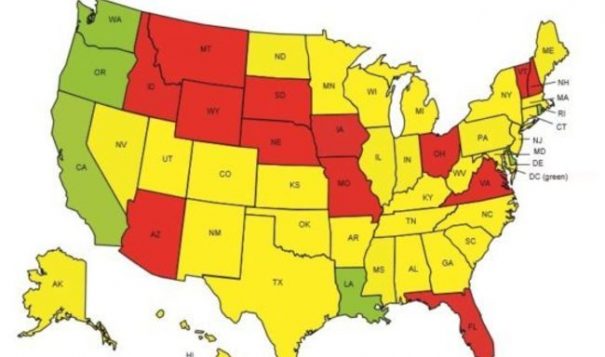 States in green have done the best job of improving traffic safety by adopting protective laws, according to a report card by Advocates for Highway and Auto Safety. Red states were rated worst in the group’s rankings and yellow states are in between.
States in green have done the best job of improving traffic safety by adopting protective laws, according to a report card by Advocates for Highway and Auto Safety. Red states were rated worst in the group’s rankings and yellow states are in between.
Amid a resurgence in U.S. traffic fatalities now taking roughly 100 lives a day, an advocacy group today issued a report card identifying states that do the most, and least, to improve highway safety.
The ratings by Advocates for Highway and Auto Safety credited six states — California, Oregon, Washington, Louisiana, Delaware and Rhode Island—with having the most protective road safety laws.
The safety group ranked 13 other states– Arizona, Idaho, Montana, Wyoming, South Dakota, Nebraska, Iowa, Missouri, Ohio, Virginia, Florida, Vermont and New Hampshire — at the bottom.
The ratings, issued annually, were based on how many of the 16 laws that the safety group considers most important in preventing injuries and deaths are on the books in each of the states. They include laws on mandatory seat belt and motorcycle helmet use, licensing of novice drivers, protection for infants and toddlers, and safeguards against impaired and distracted drivers.
Advocates for Highway and Auto Safety’s president, Catherine Chase, noted the “tremendous focus” in recent years on the potential for driverless cars “to revolutionize our transportation system.” But, she said, In the short term, “we have proven traffic safety laws and advanced vehicle technologies available now that could be saving thousands of lives every year.”
Federal officials estimated that 37,461 people were killed in traffic crashes in 2016, a one-year increase of 5.6 percent. During 2016, pedestrian deaths jumped 9 percent, and fatalities involving drivers at least 65 years old were up 8.8 percent. In 2015, fatalities rose 8.4 percent from the year before, the largest one-year percentage increase in nearly half a century.
Preliminary figures for the first half of 2017 show a slight decline from 2016, but with fatalities still up from the first half of 2015.
To cut the death toll, the safety group called for strong state laws to crack down on impaired driving and to require seat belt and motorcycle helmet use. In 2016, almost half of all occupants of passenger vehicles who were killed weren’t wearing seat belts. Motorcyclists accounted for another 14 percent of all crash death victims.
Only five states, according to the new report, have helmet requirements for all motorcycle riders, as well as primary front and rear seat belt requirements. Such seat belt laws allow police to issue tickets without finding other violations.
More than one in every four crash deaths involves a drunk driver. But only 20 states, the safety group says, have laws providing all three of the following: requirements for ignition interlock devices for all offenders, increased penalties for drunk drivers transporting children and comprehensive open container laws.
All but seven states now have laws forbidding drivers from text messaging while behind the wheel. But many states have failed to ban all types of cell phone use by teen drivers, the report says.
In all, 13 states adopted legislation promoting better vehicle safety last year. But more needs to be done by both manufacturers and government, the safety group says.
“Crash avoidance technologies such as automatic emergency braking and lane departure warning should be standard equipment in all passenger cars and commercial motor vehicles,” Chase said. “And, ensuring the safety of vulnerable rear seat passengers including children and teens needs to be prioritized through the installation of rear seat belt reminders and other technological tools.”
At a midday Washington, D.C. press conference, leaders of the safety group were joined by representatives of Mothers Against Drunk Driving, the American Public Health Association and KidsandCars.org to urge states to adopt more safety measures.
“Our country is approaching nine years without a single person being killed in a commercial aviation crash,” said Jackie Gillan, president emeritus of the Advocates group. “Yet today, we can’t go 15 minutes without a single person being killed in a motor vehicle crash.”
This story was reported by FairWarning, a nonprofit news organization based in Pasadena, California, that focuses on public health, consumer and environmental issues.
